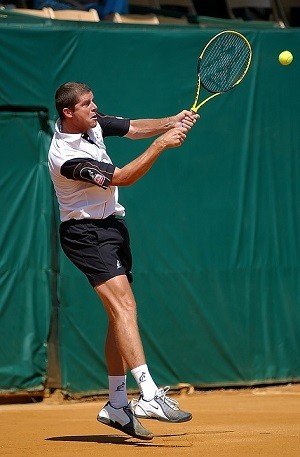|
Tennis Racquets |
GRIP SIZE
How well you grip a racquet is important because it can affect maneuverability, control, and power.
To determine your grip size, hold out your playing hand flat with fingers close together. Take a ruler and vertically measure from the middle crease that runs across the center of your palm up to the inside tip of your ring finger (nearest your middle finger).
In my case, the measurement was 4-1/2 inches. So I would compare that number with the grip sizes being offered for the racquet. I’ve noticed that for some models on the market, there isn’t an exact grip size of 4-1/2 inches. I often see 4-3/8″ and 4-5/8″. In this case, I would opt for the smaller 4-3/8 inch grip. In fact, this is the most popular grip size.
The rule of thumb is that if your measurement falls in between available grip sizes, always go with the smaller size. While you can quickly and easily thicken the handle and grip area on the fly using overgrip tape, the same can’t be said about reducing it. So, again, when in doubt, go smaller.
STRING PATTERN
Racquets can have different crisscrossing string patterns to accommodate each player’s performance goals. These patterns are typically categorized as either open or dense. And the strings are classified as mains (the ones that run vertically up and down) and crosses (the ones the run horizontally).
The most frequently used open pattern has 16 (mains) x 19 (crosses). And the most frequent closed pattern has 18 (mains) x 20 (crosses).
Some of the pros and cons of each of these stringing patterns include the following:
Open (16×19)
– More spacing between strings makes it easier to add spin to the ball
– More power
– Strings are a little less durable
Closed (18×20)
– Less spacing between strings makes it easier to control the direction of shots
– Strings may not snap as often
– Weaker trampolining effect when striking the ball
Now, having said all of the above, you will find additional stringing patterns, such as 16×20, 16×15, 18×17, 18×19, etc. No doubt, you’ll have to try out a particular pattern to assess whether you like the action it provides or not.
And as a final note for this section, if you break a string, don’t continue to play with the racquet. It may still feel sturdy, but you risk damaging the frame. And once the frame gets even a little bit out of kilter, it will be rendered useless permanently.
Types of Stringing Material
OVERALL WEIGHT
 When you look closely at a tennis racquet, it’s easy to understand why someone would view it as an unwieldy piece of equipment. After all, it’s more than 2 feet long, and only a small area can be used to hit the ball, while you’re running around lifting and swinging it for two hours.
When you look closely at a tennis racquet, it’s easy to understand why someone would view it as an unwieldy piece of equipment. After all, it’s more than 2 feet long, and only a small area can be used to hit the ball, while you’re running around lifting and swinging it for two hours.
That’s why it can’t be heavy.
Today’s sticks hover around 11 ounces, on average. And of course, you can certainly find some that are heavier or lighter. But that’s a far cry from past versions.
The weight of the racquet will also be an indicator of which performance parameter you want to be the cornerstone of your game.
Do you want to exert supreme control over the racquet and placement of the ball? Or, is it your desire to hit blistering returns past your opponents that they barely see? Or, maybe you’d like to find a model that offers a great mix of both?
Regardless, if you tell me your game, I’ll tell you the ideal weight. Here are some basic guidelines:
Power Players (Racquet Weight: 9-10 oz.)
– You have a tight, compact swing
– You are NOT a big, physically imposing athlete
– You need a forgiving frame that will help to improve your serve and ground strokes
– Your skill level is beginner
Control Freaks (Racquet Weight: 11+ oz.)
– You have excellent foot speed
– You have a strong physical stature
– Your skill level is intermediate to advanced
– You possess the physical strength to put pace on the ball
Tweeners (Racquet Weight: 10-11 oz.)
– You want to put more spin on the ball
– You could be a junior player who is moving up to an adult racquet
– Your skill level is intermediate or advanced
You should also know that depending on how your racket is strung, that could add up to another ounce to the overall weight.
Conclusion
In conclusion, there are a number of factors that make tennis racquets perform differently. Head size, frame flexibility, string pattern, and more can all impact power and control. But as we’ve mentioned, the rule of thumb for beginners is to seek sticks with larger heads, stiffer frames, and lighter weights. And for advanced players, the opposite is true. See you on the court!
>>>>Introduction: Racquet Construction & Anatomy>>>>
| Page 1 | Page 2 | Page 3 | Page 4 | Page 5 |

